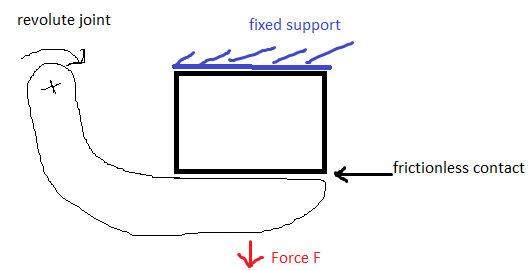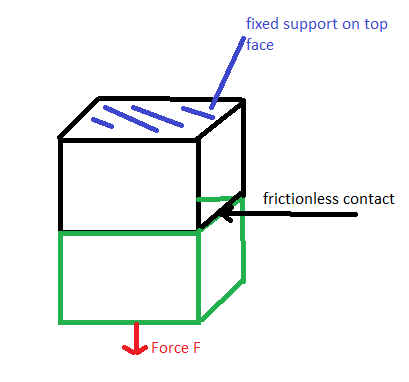TAGGED: constraints, contacts
-
-
December 7, 2021 at 4:37 pm
m.caragiuli
SubscriberHello,
I do not understand the problem of the model represented in the picture. Could you please help me?
December 7, 2021 at 6:33 pmpeteroznewman
SubscriberIn a Static Structural analysis, all the bodies must have stiffness relative to ground in six DOF (three translations, three rotations).
With two blocks, when the lower block is bonded, it has a 6 DOF connection to ground.
When the contact is No Separation, the block only has 3 DOF connected to ground, while three DOF have zero stiffness relative to ground. Those are the two translations in the plane and one rotation. This causes a failure in the solver.
When the contact is Frictionless, and the force is in a direction to open the contact, there is zero stiffness to ground in that direction so the block has zero stiffness to ground in 6 DOF and the solver fails.
December 7, 2021 at 8:45 pmm.caragiuli
SubscriberHi,
thanks for the answer.
Is there a way to solve the issue?
I do not understand how to use frictionless contact since the body that should separate out should always be constrained to avoid rigid body motion.
However, given that how can I constraint the body that separates out? Could a spring connecting that body to the ground suffice? Or should it be connected to the above box? A spring could prevent translation in 2 directions and three rotations I think.
Thanks
December 7, 2021 at 8:54 pmpeteroznewman
SubscriberFrictionless contact can only work if you reverse the direction of the force and add enough springs to prevent zero stiffness in the 3 DOF that the No Separation contact has.
December 7, 2021 at 9:50 pmm.caragiuli
SubscriberWhy reverting the force direction? Then the movement and the stress would be different...
December 8, 2021 at 10:59 ampeteroznewman
SubscriberMaybe I am misinterpreting your drawing. My understanding is that the red force arrow acts on the green block to pull it down.
If you have two blocks with a frictionless contact between them and pull them apart, there will be no connection between them and no solution to a static structural analysis. The stress will be zero.
If you have two blocks and push them together, there is a connection and with sufficient other boundary conditions, there will be a solution to the structural analysis and the stress will be non-zero.
December 9, 2021 at 4:24 pmm.caragiuli
SubscriberYou are correctly interpreting the model Peteroznewman, but if frictionless contact means that separation is allowed how one can use it to mimic this separation? If I revert the force the blocks will interpenetrate.
December 9, 2021 at 6:12 pmpeteroznewman
SubscriberWhat is the question you are trying to answer with this model?
What do you want to measure?
December 10, 2021 at 5:58 pmm.caragiuli
SubscriberI just want to simulate the behaviour of the mandible during opening due to gravity force. The model drawn in the picture is really simplified. Following a better picture which includes the mandible with a revolute joint to allow rotation up to a certain angle (through a stop).

In this case, without a spring between the mandible and the upper box, the model diverges due to bad constraints. However in this case the mandible has just the possibility to rotate about an axis up to a certain angle then stop will occur.
December 10, 2021 at 10:45 pmpeteroznewman
SubscriberI suggest you create a model in Rigid Dynamics.
Use a revolute joint to ground on the mandible.
Turn on Standard Earth Gravity in the downward direction to exert a force on all the bodies.
Put frictional or frictionless contact between the black block and the mandible, as well as the black block and the body above that is fixed to ground.
If there is no torque on the revolute joint, gravity will pull the mandible and black block downward and the block will slide off the mandible and fall freely.
December 14, 2021 at 9:02 amm.caragiuli
SubscriberThank you!
December 15, 2021 at 5:31 pmm.caragiuli
SubscriberI just want to simulate the behaviour of the mandible during opening due to gravity force. The model drawn in the picture is really simplified. Following a better picture which includes the mandible with a revolute joint to allow rotation up to a certain angle (through a stop).

In this case without a spring between the mandible and the upper box the model diverges due to bad constraints. However in this case the mandible has just the possibility to rotate around one single axis and up to a certain angle thus I do not understand the problem.
Thanks
December 15, 2021 at 6:14 pmpeteroznewman
SubscriberIf you want to upload your .wbpz Archive file, I will take a look at it. Say what version of ANSYS you are using.
Viewing 12 reply threads- The topic ‘constraints problem of a model’ is closed to new replies.
Innovation SpaceTrending discussions- LPBF Simulation of dissimilar materials in ANSYS mechanical (Thermal Transient)
- Real Life Example of a non-symmetric eigenvalue problem
- How can the results of Pressures and Motions for all elements be obtained?
- BackGround Color
- Contact stiffness too big
- Element Birth and Death
- Python-Script to Export all Children of a Solution Tree
- Which equations and in what form are valid for defining excitations?
Top Contributors-
4592
-
1494
-
1386
-
1209
-
1021
Top Rated Tags© 2025 Copyright ANSYS, Inc. All rights reserved.
Ansys does not support the usage of unauthorized Ansys software. Please visit www.ansys.com to obtain an official distribution.
-
The Ansys Learning Forum is a public forum. You are prohibited from providing (i) information that is confidential to You, your employer, or any third party, (ii) Personal Data or individually identifiable health information, (iii) any information that is U.S. Government Classified, Controlled Unclassified Information, International Traffic in Arms Regulators (ITAR) or Export Administration Regulators (EAR) controlled or otherwise have been determined by the United States Government or by a foreign government to require protection against unauthorized disclosure for reasons of national security, or (iv) topics or information restricted by the People's Republic of China data protection and privacy laws.












